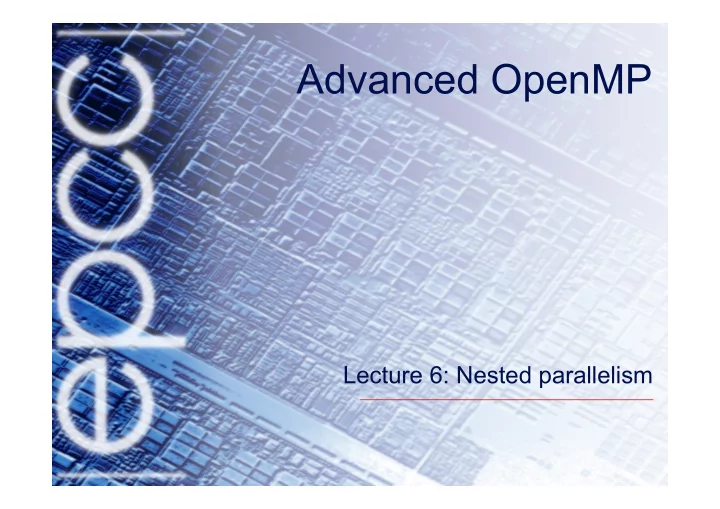

Advanced OpenMP Lecture 6: Nested parallelism
Nested parallelism • Nested parallelism is supported in OpenMP. • If a PARALLEL directive is encountered within another PARALLEL directive, a new team of threads will be created. • This is enabled with the OMP_NESTED environment variable or the OMP_SET_NESTED routine. • If nested parallelism is disabled, the code will still executed, but the inner teams will contain only one thread. 2
Nested parallelism (cont) Example: !$OMP PARALLEL !$OMP SECTIONS !$OMP SECTION !$OMP PARALLEL DO do i = 1,n x(i) = 1.0 end do !$OMP SECTION !$OMP PARALLEL DO do j = 1,n y(j) = 2.0 end do !$OMP END SECTIONS !$OMP END PARALLEL 3
Nested parallelism (cont) • Not often needed, but can be useful to exploit non-scalable parallelism (SECTIONS). – Also useful if the outer level does not contain enough parallelism • Note: nested parallelism isn’t supported in some implementations (the code will execute, but as if OMP_NESTED is set to FALSE). – turns out to be hard to do correctly without impacting performance significantly. – don’t enable nested parallelism unless you are using it! 4
Controlling the number of threads • Can use the environment variable export OMP_NUM_THREADS=2,4 • Will use 2 threads at the outer level and 4 threads for each of the inner teams. • Can use omp_set_num_threads() or the num_threads clause on the parallel region. 5
omp_set_num_threads() • Useful if you want inner regions to use different numbers of threads: CALL OMP_SET_NUM_THREADS(2) !$OMP PARALLEL DO DO I = 1,4 CALL OMP_SET_NUM_THREADS(innerthreads(i)) !$OMP PARALLEL DO DO J = 1,N A(I,J) = B(I,J) END DO END DO • The value set overrides the value(s) in the environment variable OMP_NUM_THREADS 6
NUMTHREADS clause • One way to control the number of threads used at each level is with the NUM_THREADS clause: !$OMP PARALLEL DO NUM_THREADS(2) DO I = 1,4 !$OMP PARALLEL DO NUM_THREADS(innerthreads(i)) DO J = 1,N A(I,J) = B(I,J) END DO END DO • The value set in the clause overrides the value in the environment variable OMP_NUM_THREADS and that set by omp_set_num_threads() 7
More control … . • Can also control the maximum number of threads running at any one time. export OMP_THREAD_LIMIT=64 • … and the maximum depth of nesting export OMP_MAX_ACTIVE_LEVELS=2 or call omp_set_max_active_levels() 8
Utility routines for nested parallelism • omp_get_level() – returns the level of parallelism of the calling thread – returns 0 in the sequential part • omp_get_active_level() – returns the level of parallelism of the calling thread, ignoring levels which are inactive (teams only contain one thread) • omp_get_ancestor_thread_num( level ) – returns the thread ID of this thread’s ancestor at a given level – ID of my parent: omp_get_ancestor_thread_num(omp_get_level()-1) • omp_get_team_size( level ) – returns the number of threads in this thread’s ancestor team at a given level 9
Nested loops • For perfectly nested rectangular loops we can parallelise multiple loops in the nest with the collapse clause: #pragma omp parallel for collapse(2) for (int i=0; i<N; i++) { for (int j=0; j<M; j++) { ..... } } • Argument is number of loops to collapse starting from the outside • Will form a single loop of length NxM and then parallelise and schedule that. • Useful if N is O(no. of threads) so parallelising the outer loop may not have good load balance • More efficient than using nested teams 10
Synchronisation in nested parallelism • Note that barriers (explicit or implicit) only affect the innermost enclosing parallel region. • No way to have a barrier across multiple teams • In contrast, critical regions, atomics and locks affect all the threads in the program • If you want mutual exclusion within teams but not between them, need to use locks (or atomics). 11
Recommend
More recommend